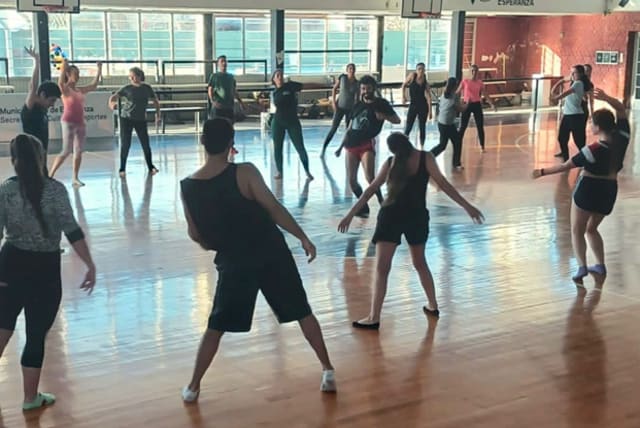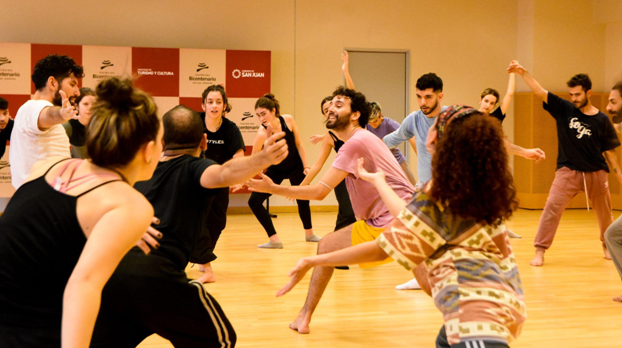César Brodermann brings the Gaga movement to Argentina: An interview with the Mexican dancer

In the world of dance, professionals are often perceived as disciplined individuals who strive for perfection through rigorous training and sacrifice. However, there are dancers and choreographers who seek to challenge these stereotypes. One such artist is César Brodermann, a Mexican dancer and promoter of the renowned dance movement called Gaga, developed by Israeli choreographer Ohad Naharin. Gaga is a language of movement and a pedagogy developed in 1990 by the prestigious Ohad Naharin, one of the most influential choreographers of all time. This tour was co-organized with the national ministry of Culture, within the framework of MICA (Argentinian Market of Cultural Industries). Ohad created his own technique of body expression, which is characterized by keeping the arms, legs and back flexible, while the body is supported by a deep rooting in the ground, which allows explosive and dynamic movements. The main objective for Naharin is that those who develop it feel within themselves each part of their body and each detail of the movement.
Supported by the Department of Public Diplomacy of the Embassy of Israel in Argentina, Brodermann recently embarked on a tour across several cities in Argentina, offering free Gaga masterclasses.
César Brodermann is a multidisciplinary queer artist, contemporary dancer, choreographer, photographer, and artistic director. In 2018, he settled in Tel Aviv, where he served as the first Mexican dancer in one of the most internationally recognized dance companies, the Batsheva Dance
Company- Young Ensemble, under the direction of Gili Navot.
We had the opportunity to sit down with him and discuss his experiences, the benefits of Gaga, and his passion for dance.
Q. How were your classes received in Argentina?
A.The dancers who joined my masterclasses had a very open sensibility and have absorbed a lot of everything I had to offer. I liked the experience that was lived in each one of the provinces, since although they are different, the people have been quite flexible and were very interested in applying all the characteristics of this language to learning or more traditional training.
Q. What benefits can Gaga bring to dance studies?
A. What I came to share is Ohad Naharin's language of movement. It comes from improvisation, learning to move from sensations rather than from form. For example, in classes we don't use mirrors as is customary in most dance spaces; we don't allow people watching the class because we believe that we can all move. In Argentina, we only did Gaga classes for professional dancers, but it is a language that we also apply to people who have never danced, because we strongly believe that movement is for everyone. The class lasts one hour and 15 minutes, and we are in continuous movement. This way, we manage to break our habits and reach beyond the limits. Ohad Naharin's Gaga language of movement was developed to give us a toolbox for dancers, either classical, contemporary or any type of dancer, and thus make you have more instruments to be able to dance faster, with a wider range, with improved emotions and to be able to connect better with your body. It is not a technique that is put on a show, nor a repertoire or a choreography.
Q.How was your experience at the Batsheva Dance Company, in Tel Aviv, where you were from 2018 to 2022?
A. I am a multidisciplinary artist, I do my own dance, movement, film and photography work. And I think I achieved it thanks to the fact that the Batsheva Company supported us to develop as individual artists as well. It's something that doesn't happen in many dance companies, because they are looking for performers, people who do things perfectly. But in Batsheva, they are looking for artists who have a point of view. So along with being in the company, learning Gaga and becoming a professional, we can do our own research in the arts and find our voice. This way, I feel we are better dancers, artists and persons.

Q.How do you continue to maintain that passion for dance?
A. It gets complicated when it becomes a job, but I feel like you always have to remember why you did it in the first place. I never did it for money or to be famous. I do it because I have always loved to dance and it has been like a way out of this world that is so chaotic and complicated. I remember these things when I teach, especially “Gaga/People”, because you can see a 75-year-old person moving and enjoying her body without anyone telling her that it has to be perfect or that it has to be better. Those reminders have always helped me to keep moving forward, because it can happen that sometimes you start to lose that passion.
Q.When did you realize that you wanted to be a professional dancer?
A.Since I was little I knew that movement had to be part of my life. It has always been a way out. When I was six years old, my dad, who was a musician, made a song called “Dancing shoes” in my honor and he didn't even know I was going to be a dancer. I was always hyperactive. At the age of 15, I began to become better at dancing and thought this is what I wanted to do. First, I had the opportunity to travel to New York on a scholarship at the age of 17. There, I had my first approach to Gaga, which interested me a lot and I really felt I connected with this language. Then, I auditioned for the company in Israel and became the first Mexican in the company’s history. It was so great to be able to open these bridges for other people.
Giving these classes, many Argentines asked me how I did it and I believe that being able to tell our stories inspires more people to say for example “I’m in San Juan (Argentinian province far from Buenos Aires), I can get to dance in the number one contemporary dance company one day”. It was very nice to be able to inspire younger generations of dancers to achieve their dreams, since it is usually very difficult to reach these places. Thankfully, not impossible.
Q.Did you have to make many sacrifices to achieve your goals?
A. At the age of 17 I moved to New York alone, and from there I feel that I gradually adapted to that reality. The dance career includes loneliness because if you have the chance to travel, you have to make the sacrifice of being away from your family. But after a short time, you have already formed a new family. The people from the company and the ones I met there became my family. I call them "the people who made me survive" because dance is very difficult and if you don't have those people who hug you and accompany you, it would be more difficult to go through those challenges. I arrived in Israel four years ago and it was very interesting to see how the Mexican and Israeli cultures had many similar things: people hugged me, they were very open and I think that is something that all Latinos have. Therefore, it wasn't that hard for me to adapt. Also, Tel Aviv is beautiful. I lived very close to the sea, and it was a wonderful experience. As a person from the queer community, living in cities like New York or Tel Aviv, which are very open places, made me feel free. But now, back in Mexico City, I feel it is a very free place, but with its limitations. I began to realize that it doesn't matter where you are, but how you feel; and maybe, this freedom comes from within ourselves. Dance makes us feel free. It is one of Gaga's basic concepts, where everyone can dance and connect with this freedom thanks to movement.

